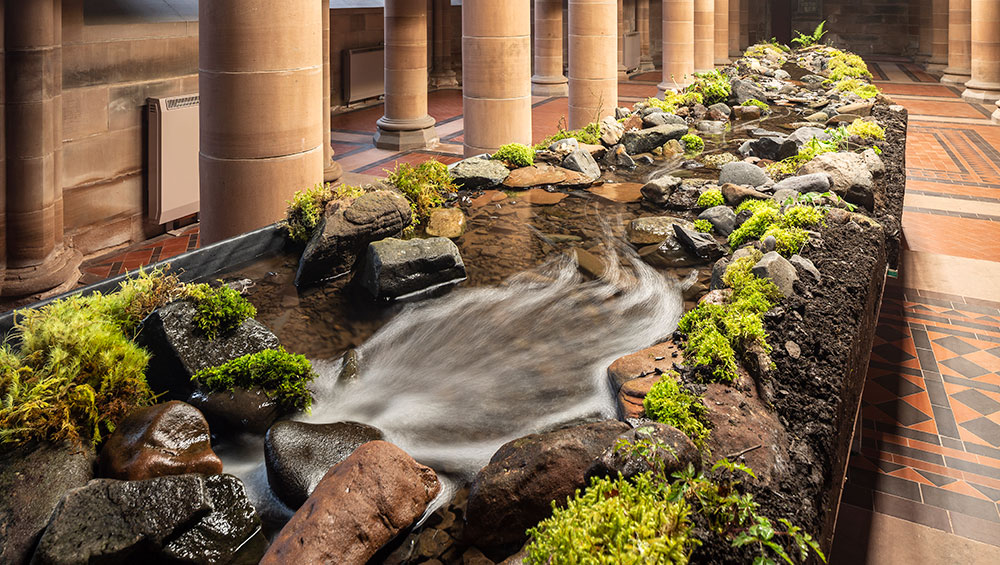
Abbas Akhavan, variations on a folly (detail) (2022). Courtesy the artist, The Third Line (UAE) and Catriona Jeffries (Canada). Photo: Keith Hunter.
by VERONICA SIMPSON
Abbas Akhavan has been up almost all night when we meet at 11am, finishing the work he has newly installed in Mount Stuart’s crypt on the Isle of Bute. As the latest recipient of the annual artist-in-residence award based at the Scottish island’s most spectacular neo-gothic pile, he has had three months to gestate the resulting, site-responsive works, but it sounds as if the final push took him up to the wire. Finding a comfy, moderately opulent living room for our interview, he lies down on a purple velvet sofa, kicks off his boots and puts his feet up. “I don’t usually do this,” he says, “but I’ve been working since 10am non-stop until 4am and then 6am until now. It’s physical labour,” he emphasises. “The earth ramming, the river, carrying heavy stuff, extremely labour intensive.”
I am baffled until I later see the work, Variations on a Folly (2022), installed in the mansion’s red sandstone crypt. I get the reference to heavy labour, and also the twist in the title: where the historical British folly was usually an ornamental, anomalous building placed in the manicured gardens of a country pile, this one is a naturalistic brook running through the pillars of this ornamental building.
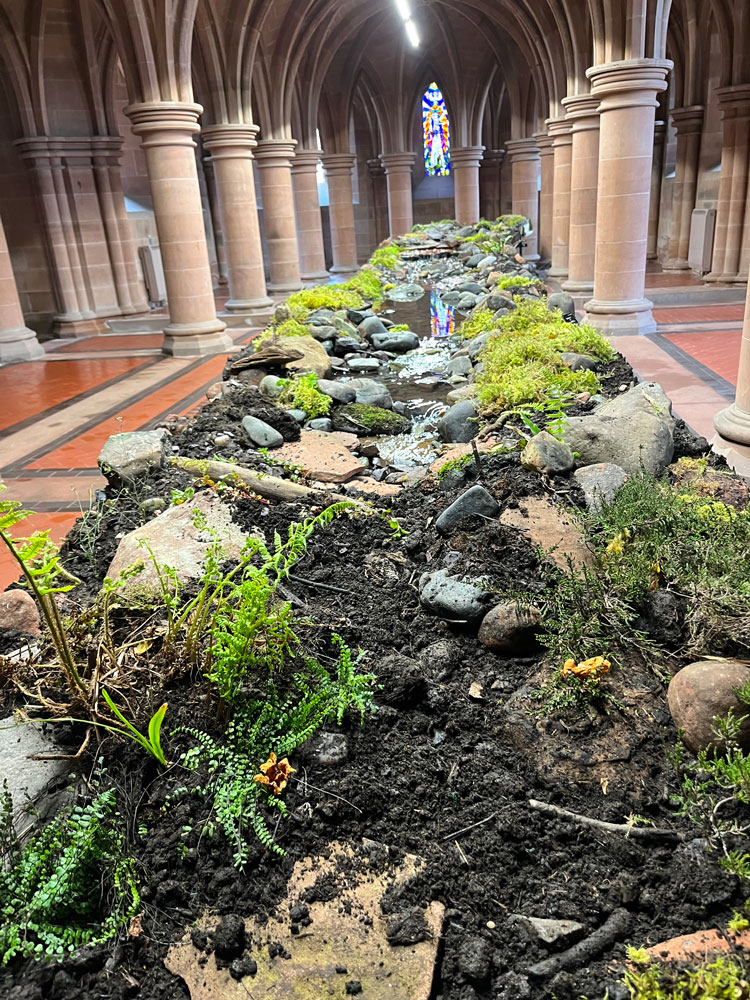
Abbas Akhavan, Variations on a Folly, 2022. Photo: Veronica Simpson.
There are three other works, too. There is a sound work, adapted from an older work, You Used to Call It Blue Sometimes (2022), in which Akhavan collages the recorded reactions of people with colour blindness when they are shown the world of colour as the rest of us experience it, thanks to donning chromatically adjusted glasses. This 20-minute audio clip is supposed to be listened to as you go from the house through the garden (which was, in late spring, a riot of colour, it being peak rhododendron season) to a striking glasshouse pavilion, in which he has also placed a companion piece: chromatically enhanced film is layered over some of the glasshouse windows, which skews your perception of colour all over again.
Also in the glasshouse is Slug (2020), a hilarious four-minute film in which Akhavan plays puppet-master with a purple snapdragon, making it talk to camera, while conveying, through subtitles, its pompous monologue about the typical form and content of nightmares. The screen is nestled into the glasshouse’s exotic foliage, just above a coy carp pond; the carp seemed entranced with it when I visited.
,-in-the-Glass-Pavilion.jpg)
Abbas Akhavan. Still from the film Slug (2020), in the Glass Pavilion, Mount Stuart. Photo: Veronica Simpson.
Akhavan, who was born in Tehran in 1977 and now lives in Montreal, has established a name for himself with site-specific installations, using sculpture, drawing, video and performance to reveal something of the architecture and social or cultural context in which they are housed, often by importing elements that are quite alien. He highlights, in essence, the constructed nature of our interior and exterior landscapes.
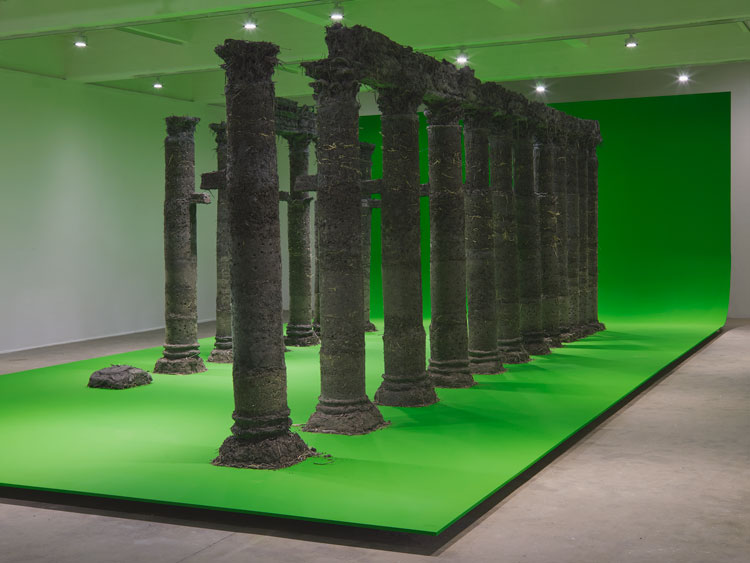
Abbas Akhavan, Curtain Call, Variations on a Folly, 2021. Installation view, Chisenhale Gallery, London, 2021. Commissioned and produced by Chisenhale Gallery, London. Courtesy of the artist. Photo: Andy Keate.
For Curtain Call, Variations on a Folly (2021), his show at the Chisenhale in London, in 2021, he constructed a seemingly ruined temple out of clay and straw in the gritty, urban gallery space, placing it against a green-screen background to trigger conversations about landmarks out of context, and the staged nature of historical museum trophies (often mere simulations of the real thing). He also installed one of his “roof texts” on the roof of the Chisenhale Gallery and Studios: the words Cat’s Paw, inspired, he told the show’s curator, Ellen Greig, by the idiomatic use of the phrase to mean someone or something being used as a tool by someone else. He said of the text, which was visible only to those flying over the building (although it was displayed on the website): “I like the idea of people coming into the gallery space and imagining something urgent or poetic above them, sending messages further than them.”
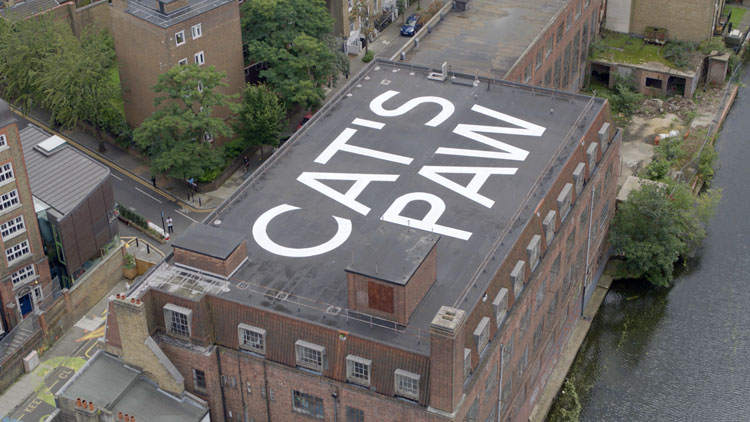
Abbas Akhavan, Cat's Paw, 2021. Aerial view, Chisenhale Gallery, London, 2021. Commissioned and produced by Chisenhale Gallery, London with support from Concrete Projects. Courtesy of the artist. Photo: Ali Sadeghian.
Akhavan is something of a serial artist-in-residence. By his reckoning, he has done 19 residencies over his career – and he is not yet 45. He applied for only one of them; the rest came by invitation. And he has been to some of the most desirable and intriguing locations – Atelier Calder in France, Fogo Island in Canada and Flora ars+natura in Colombia – and some of the most prestigious – the Delfina and the Chisenhale, both in London.
He completed his BA in Fine Art in 2004, at Concordia University, Montreal, and his MA in 2006, at the University of British Columbia, Vancouver. His solo exhibitions include one at the CCA Wattis Institute, San Francisco (2019) and another at the Museum Villa Stuck, Munich (2017). He has featured in many group exhibitions, including at the Palais de Tokyo, Paris (2022), and at the Liverpool Biennial (2018).
Veronica Simpson: Tell me, when you get a residency, what is your process? How do you go about thinking what you might do? Is it a deep dive into the history, the historical context, or more spontaneous, instinctive?
Abbas Akhavan: To be honest, it takes a few turns. Over the years, I’ve done about 19 residencies. And almost every solo show is a one- month install. Even when I’m not doing a residency, I’m usually making the work on site. So, some things govern how I go about positioning myself, including often not looking like people from where I’m going, because my residencies are often small places, such as Fogo Island. And I did a residency in Dubai, in a heritage house. I’m not Emirati, I’m not Scottish, I’m not white Irish-Canadian living on Fogo Island. I have to also just be wary of my interjection into people’s lives. I’m not interested in that. It never has to do with gaining access to a sort of narrative that’s of the people or personal. I tend to keep quite private.
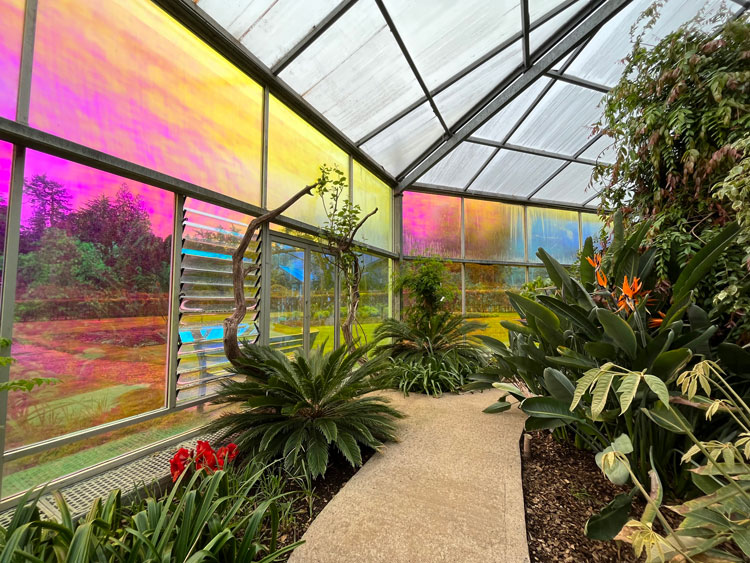
Transparent dichroic film in Mount Stuart Glass Pavilion. Photo: Veronica Simpson.
VS: But what was it about this crazy neo-gothic pile in Scotland that appealed to you? Had you been to Mount Stuart before?
AA: I came here three or four years ago. I was in London installing, so I came here for a week. The visits are often in conjunction with another trip nearby and, instead of going back and forth, I stay as long as possible. In this case, it was three months. We don’t ship work often – by we, I mean me in conjunction with the gallery or institution I’m working with. I don’t ship work. And the materials are more or less available on site. Often, when I leave, they turn into raw materials again. If it’s site specific or site inspired, or site related, it doesn’t make sense to carry things away. Some works can crawl. You can recreate them somewhere with a different connotation.
Every place has its own weird histories and aesthetics. For example, with a residency I did at the Delfina Foundation, it was important to me not to be making a work that is excavating a narrative of a resident. I’m not interested in those things. To be honest, my work, though it’s of me, is not about me. And I don’t like to make work that’s expressive. And even the monuments I’ve worked with are not really dear to me as much as dear to a moment in history or important or vibrant. That’s where the material comes from. And my inspiration comes from reading the news a lot, being alone a lot. In the case of here, I thought: what do you do in a 19th-century enchanted, materially over-the-top castle? How do you bring something that carries vibrance in such a vibrant space, and not have it become depleted? Most of my work deals with gardens. For me, that’s a space where nature is negotiated through culture, and vice versa sometimes. I don’t believe in nature as an entity that we can indulge in. It ceases to exist when we see it even, because we immediately proceed to domesticate, translate, mistranslate and, in the long term, preserve it potentially for the wealthy to live on. It’s never just for its own entity.
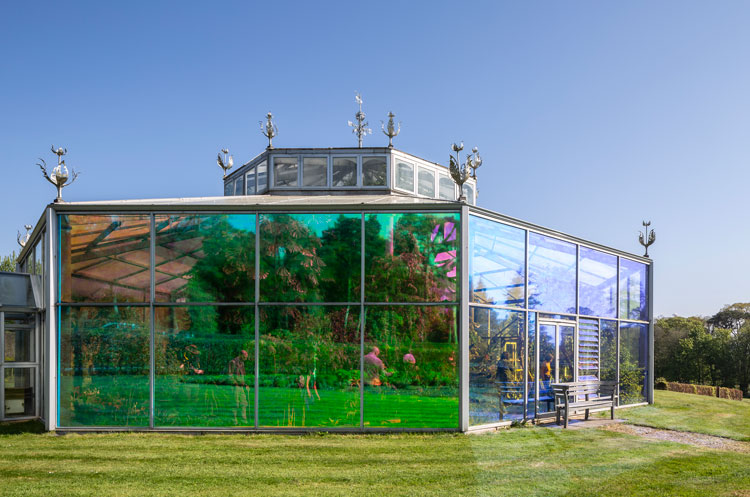
The Glass Pavilion at Mount Stuart with transparent dichroic film.
Here, the garden is quite omnipresent, obviously. And I thought the only thing that’s of this place but not of the value that’s inside it is all the material around it. I was really interested in that distinction. There are paintings by Poussin and Velázquez in here. So, I thought we just work with things that have a value but no worth. But it’s also a way to make people use the artwork as a lens to highlight what’s already here, as opposed to introducing something new.
VS: Yes, but if you’re going to invest that amount of time somewhere, there has to be something that persuades you it is worth that investment. Where do you find that traction? What are the components you are looking for?
AA: It’s that kind of thing: if it’s wealthy, I can go to depleted materials. If it’s white cube, I create a stage to talk about the constructed-ness of the white cube. And, subsequently, saying that this artwork is on stage gives it liberty to be more self-conscious and do whatever it wants. It’s not an artwork, it’s an acting placeholder - a platform that provides freedom to lose context almost and, like theatre, become more make-believe. In this place, it was a case of pulling back. You definitely don’t compete with it.
I remember something Richard Tuttle said in an interview – he makes these beautiful small sculptures, and there’s a modesty in their economy and means of making. He said that, at one point, abstract expressionism was so big and was going bigger and bigger and more expressive. And he thought, if there’s all this bigness, there must be a vacuum of desire for these smallnesses.
In this kind of place, those words lingered with me: you don’t compete with what’s faster than you. You reanalyse the race. And you go at your own pace, take your own path.
In this case, I was really taken by these rivers. I came here knowing a little about the landscape, but then reading a lot and realising how, because it’s pastoral and of nature, we presume it to be natural. But these were all boggy, wet, non-habitable spaces that they transformed. There are four words I’d like to make a rooftop work with: ditches, dykes, drains and hedges. I’d like to make that on a rooftop, in Scotland – not here, though.
I started to read about how much water gets rerouted. These rivers were all rerouted for religious or sentimental or visually appealing reasons. I thought about the river. I’ve been working on follies for a long time. There’s a folly here, so I was interested in that. This house is kind of a folly for a massive garden. And gardens are generally connotive of private property because they’re cared for. I thought we can just deal with these materials here. So, what you’ll see in the crypt is basically a river. It’s a looped river that’s running, that’s kind of indicative of a graft of this landscape here, and in this case we’re bringing the folly into the house.
Then I thought that I wanted people to walk in the gardens, for any excuse really. I’ve done a sound piece that’s 20 minutes long. It takes you from here to the glasshouse pavilion. The audio is called You Used to Call It Blue Sometimes and there’s an intervention in the space that relates to the sound work. And there’s a monitor with a video playing a piece called Slug. And that’s it. There’s a fourth piece: it’s a cellist who comes on occasion to the grounds and performs a piece. It’s unannounced. Instead of being an audience to it, you’re a witness to it. This piece I’ve been showing for a while, it’s always on this premise. It’s about 25 minutes long, and it’s just the melodic sounds of a cello that become progressively more like a groan and, at some point, it becomes the sound of a donkey braying. It’s very similar to an actual animal.
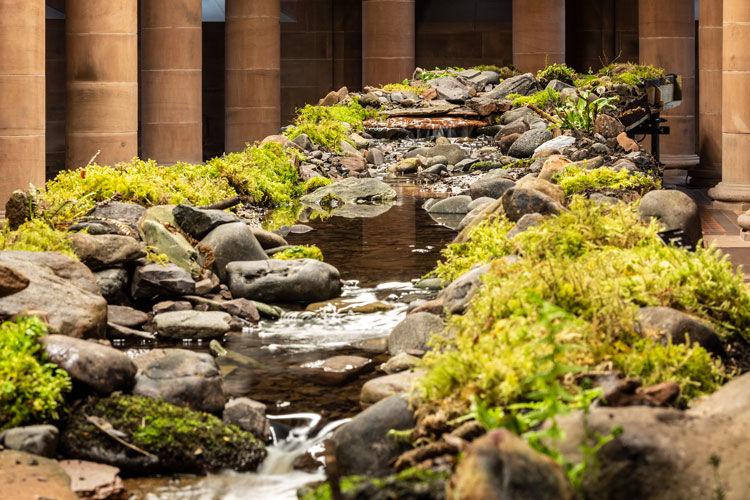
Abbas Akhavan, Variations on a Folly, 2022. Courtesy the artist, The Third Line (UAE) and Catriona Jeffries (Canada). Photo: Keith Hunter.
VS: With your folly, how difficult was it to persuade people in a historic building – where they’re usually doing everything they can to keep moisture out of the house - to let you bring a river into the house.
AA: The crypt is OK. It’s actually quite porous. A lot of air flows through it, it’s waterproof, nothing precious there. These guys have been incredible. And part of this work, too, is that you don’t parachute in. You have a three-month, day-to-day relationship with people. I get to work with them and see them at least five days a week. It’s a team. It’s my work - they’re not collaborators. It’s like being in a football team together, but I’m the goalie.
VS: When you’re immersed in a residency, do the cultural and social or historical elements of the place come into your work and influence it as you go along?
AA: It’s like you’re going through a funnel. It’s quite fast, and you’re both selfish and you’re a bit of a sponge, but you also don’t want to absorb too much. You have to develop some degree of prejudice to what you want to pay attention to obviously.
The curiosity stops at some point and you’re just making the work. The conversation becomes material, because I’m trying to resolve it in material form, outside of just coming up with the idea. It gets funnelled into narrower and narrower objectives. I spent many days here looking at rivers and trying to understand how pebbles settle and recognising that in different places. I feel deeply grateful about this, because that was my job. It’s such a gift that I was given. My job was really just learning how to see, looking. When we look, we start to understand how little we are seeing. It takes so long to really see texture and comprehend form. And I think we’re in a funny moment where there’s this constant affirmation of flatness, the way we swipe. And then the image in this space has so much range and no depth. I think: how are we looking now? I’m not judging, I’m just really curious.
I do question what the consequences of this kind of flatness are, and this illusionistic space. I’ve even been refraining from taking photos. Every time I take a photo, I remember a low-resolution, stagnant version of that memory and it starts to dominate the images around it, and erase it. Everything I try to preserve by photographing it is actually making me forget more. You look at a landscape, you take a photo, and then you take that memory over the one you saw.
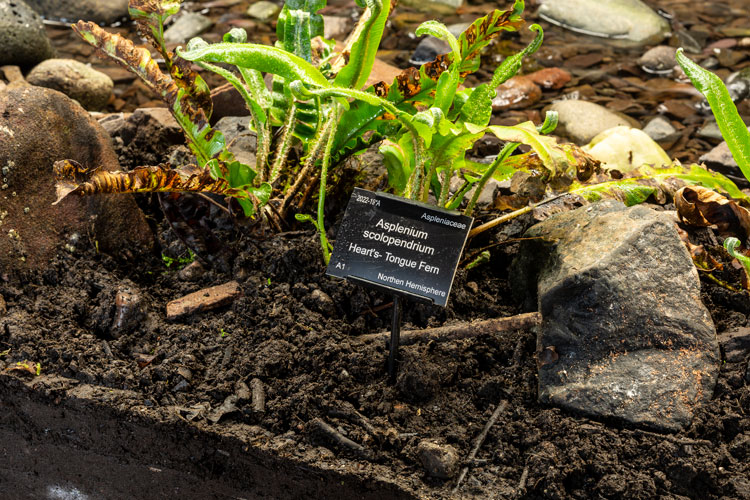
Abbas Akhavan, Variations on a Folly (detail), 2022. Courtesy the artist, The Third Line (UAE) and Catriona Jeffries (Canada). Photo: Keith Hunter.
VS: Do you think we are losing our ability to retain that memory?
AA: Yes, in its vibrance and depth. So, I’ve been looking a lot. And learning a lot about controlling water. This is the most substantial water work I’ve done. I’ve worked a lot with water and I’ve learned that we will never get along. I have to learn that I can’t control it and, in that humility, I can maybe be more cooperative and less ego-driven. I’ve done water a few times, and every time I think I can’t do this again.
VS: Given that your work is so responsive to architecture and often very architectural in nature, do you have an ambition to make something more architectural and permanent?
AA: Yes, I’d like to make a garden. My two favourite things are to make fountains and gardens. I would love to make a permanent fountain.
VS: What is it like, on a practical level, this experience of moving your home on such a regular basis, making somewhere home for three months; is it useful to your artistic process to feel displaced?
AA: I would say, I think, without sounding arrogant, that I like being a guest. I don’t feel displaced in that I’ve been received. I don’t feel at home in that I’m being hosted and I’m not home. Having said that, it’s a kind of hell. My least favourite thing to do is say goodbyes. For the first month I was here, I kept telling my partner I feel like I’m an imposter, I’m trespassing. These people want something from me, and I don’t have it. I had no idea what I was going to make. When it snags and it grips, I have a feeling. I think: “Oh, that’s the work.” But nothing was gripping and so it was really hard. Then my partner left, and I had two months after that, and I get really attached to these people. Then I have to say goodbye. It’s quite difficult but very meaningful.
But I want to get a studio when I get home. I’m almost 45 years old. I think I need to facilitate a space at home where being home isn’t idle, so I don’t feel I have to go somewhere to get working. Obviously, I’m reading and writing, but when I come here, I like this propelled intensity towards accomplishing something. I think if I set up a studio at home, I’ll accomplish more. But I’ve been very lucky with these residencies: I’ve only applied for one. The rest have been offered. With artists who want to do residencies, there are remarkable institutions out there, who are great hosts. It’s great generosity, but it comes with huge responsibility.
• Abbas Akhavan: Study for a Garden is at Mount Stuart, Isle of Bute, until 2 October 2022.